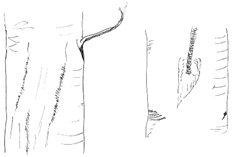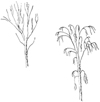Alaska Science Camps, Fairs & Experiments
ANKN is a resource for compiling and exchanging information
related to Alaska Native knowledge systems and ways of knowing. We
are pleased to create and distribute a variety of publications
that assist Native people, government agencies,
educators and the general public in gaining access to the knowledge
base that Alaska Natives have acquired through cumulative experience
over millennia.
TO ORDER THIS PUBLICATION:
Contact the ANKN
offices at 907-474-1902 or email uaf-cxcs@alaska.edu.  Selecting
a Selecting
a
Birch Tree
For centuries, Alaska Natives have made all
of their tools from local resources. Only a few materials were traded
with the Russians.
Alaska has several different kinds of trees, but there is only one
hardwood that is suitable for making dogsleds, snowshoes, and other
durable items. The Alaska birch tree stands alone being the toughest
hardwood in the state.
There are several considerations in picking a birch tree
for use. The tree must be straight splitting, have few or no knots, have
a
minimum of heartwood, and have tough fibers. There are few trees
available that have all these qualities. As oldtimers traveled, they
constantly watched for "the tree" from which they would make their
next snowshoes or sled.
It often takes longer to find the perfect tree than it does to
make the snowshoes or sled.
On the average, trees from the Lower 48, like oak, hickory, and
ash are stronger than Alaska birch. However, experience shows that a
well-chosen birch tree is tougher than commercial hickory and ash.
This is particularly true since lumber comes to us sawn from trees
with little regard for the grain of the wood. If the grain is
straight and intact, the wood of any tree is stronger than if it is
sawn.
Alaska birch does tend to rot easily, and must be stored
carefully.
Straight grain
There are several ways to determine the grain before falling a
tree and attempting to split it.
- Look at the grooves or ridges on the tree. Do they go straight
up, or do they twist to the side? Look under the knots. Often
there are grooves leading up to the knot. Are they straight or
twisted?
- Another way to check the grain is to remove some of the bark
and look at the grain. Chop a little of the wood, and peel the
fibers from the tree. Do they split straight down, or do they
twist a little to the side?
If the grain is twisted, it is better to find another one.
Snowshoes and sleds are difficult to make. It is worth the time and
effort to find the right tree.
 Knots Knots
It is very difficult to find a tree with no knots. They disrupt
the grain of the wood and weaken it, particularly on thin pieces like
snowshoe frames. There is a difference between knots, however.
Obviously some are larger than others. There are live knots and dead
knots. A live knot is the knot of a branch that was alive when the
tree was harvested. A dead knot is from a branch that was dead. Live
knots are much stronger.
 Heartwood Heartwood
Inside many birch trees is dark heartwood. This wood is contrasted
with the white wood on the outside. Heartwood isn't necessarily
weaker than the outside wood, but the water content is far less. If a
sled member has a little heartwood and the rest is white wood, it
will tend to warp strongly towards the white wood when it dries,
shrinkingmore on that side than the heartwood side.

| WARPED
STANCHEON

|
When women peel birch trees to make birch baskets, the
tree isn't killed. Oldtimers say the tree reacts by
producing much more heartwood.
It is often easy to tell how much heartwood is present in
a tree by noticing the black flecks on the bark. They look
like woodpecker holes. The more black flecks there are, the
more heartwood there is.
|
Tough fibers
Trees are like people. Some are tough and some aren't. If a tree
has tough fibers, the snowshoes and sleds will last a long time.
Strong pieces can be made smaller and therefore lighter. One tree
might be three to four times stronger than another.
There are several things that make a tree tough.
Genetics
If a tree comes from the seeds of tough trees, it too will be
tough.
Soil
A tree on good soil with proper minerals and water content can
also be a tough tree.
Location
If a tree is in a sheltered place, the fibers of the tree will
tend to be weaker. If the tree grows in a windy place, the tree will
tend to be more gnarled, but the fibers will be very strong, as the
wind bends and flexes the tree, toughening the fibers. I once built a
dogsled from small trees that had grown on a hilltop, and it was the
strongest sled I ever owned. The wind had conditioned the wood to
flex without breaking.
Picking a Tree
To choose a good birch tree, it is important to be looking all
year long. A hunter might be chasing a moose and pass a good tree in
a location he has never been before. He makes a mental note where the
tree is.
The first qualities to look for are:
- Is the tree physically straight for the length of the piece
you want to make? Are there too many knots?
- Next, look at the topmost branches. Are they straight up or
drooping? If the branches are drooping, the fibers tend to be more
flexible. If they are straight up, the tree tends to be more
brittle.
- Look for ridges on the sides of the tree or under the knots.
Are they straight up the tree or do they indicate the grain of the
tree is twisted?
- Look for the black flecks that indicate excessive
heartwood.
 Chop
a little of the bark away from the tree. Chop a few fibers and
pull them away from the tree. Do they split off quickly indicating
that the wood will be easy to break? Do they split in a way that
indicates the grain is twisted, or is it straight up and down the
tree? Bend the fibers that peel off. Are they tough or do they
break easily? If it is winter and the wood is frozen, put the wood
fibers in your mouth to thaw before bending and testing them. Chop
a little of the bark away from the tree. Chop a few fibers and
pull them away from the tree. Do they split off quickly indicating
that the wood will be easy to break? Do they split in a way that
indicates the grain is twisted, or is it straight up and down the
tree? Bend the fibers that peel off. Are they tough or do they
break easily? If it is winter and the wood is frozen, put the wood
fibers in your mouth to thaw before bending and testing them.
Splitting
You will have to ask Elders in your community to learn how to
split. Even a good, straight-grained tree will split crooked without
the proper methods. Splitting is an art.
Test the above statements by observing the qualities of different
trees. Test the fibers of five to ten trees.
 Compare
the fibers of a tree that has droopy branches to ones that have
straight branches. Which flex better without breaking? Compare
the fibers of a tree that has droopy branches to ones that have
straight branches. Which flex better without breaking?
Compare the fibers of trees grown in protected groves with those
grown in windy places. Which seem tougher?
Compare the amount of heartwood in trees that have many black
flecks on the bark with those that don't. Which have the most
heartwood? (Does someone in your village have birch in the woodpile
where you can easily observe this?)
Chop a sliver of bark from several birch trees.  Test
the exposed wood fibers. Can you detect a difference in their
strengths? Test
the exposed wood fibers. Can you detect a difference in their
strengths?
Can you tell if the grain is straight or twisted? Look for the
outward signs of twisted grain or straight grain. Compare those signs
with the actual grain. Do the outward signs give a clear indication
of the true grain of the tree?
Split a thin piece of birch from a block. Saw another piece
identical in size to the split one. Try bending them. Which bends
best?
Test a good birch tree with some strips of oak, ash, and hickory.
What conclusions can you make about quality, grain, weight, strength,
and durability?
What conclusions can you draw about selecting a good birch
tree?
|